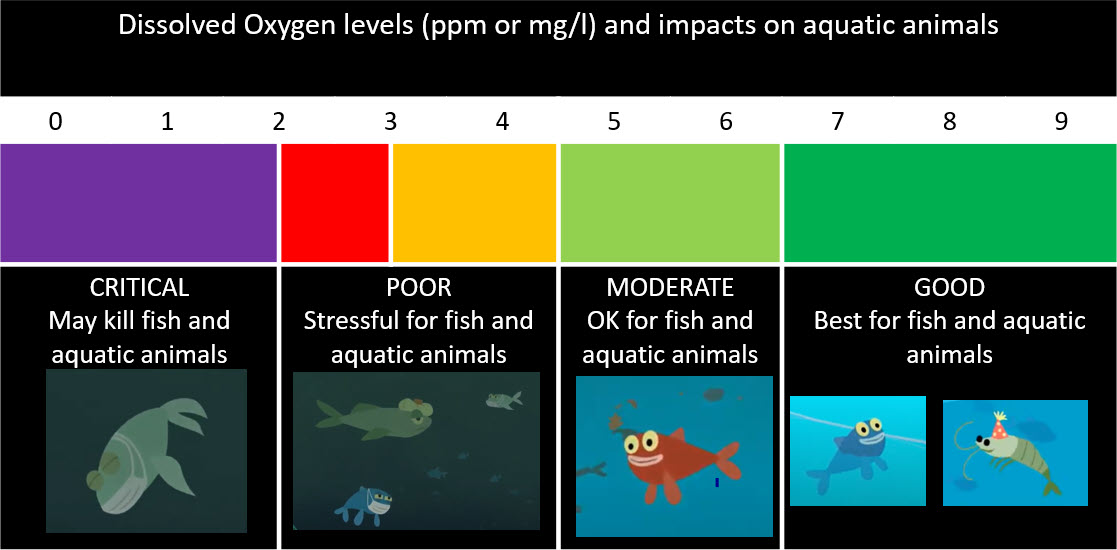In the same way land animals breathe oxygen from the air, aquatic animals such as fish and bugs use dissolved oxygen in the water to “breathe”. When the amount of dissolved oxygen in the water is low it can harm these animals.
What is dissolved oxygen and how is it measured?
Dissolved oxygen (DO) is oxygen held (dissolved) in the water and available to aquatic organisms.
The amount of dissolved oxygen in a river or stream can tell us a lot about its water quality.
Water will naturally contain a certain amount of dissolved oxygen that is absorbed from the air and produced by plants and algae living in the water.
Temperature has a large effect on the amount of oxygen dissolved in water; cold water can hold higher levels of oxygen than warmer water. Higher water temperatures over summer will cause oxygen levels to drop.
Other factors such as river flow, wind, nutrients and bacterial activity can also affect the amount of dissolved oxygen in waterways.
Dissolved oxygen concentrations are measured using scientific equipment and sensors. The sensors can be automated and provide information on dissolved oxygen levels in real time using the mobile network.
The sensors provide information on the amount of dissolved oxygen in the units of Parts Per Million (ppm) or milligrams of oxygen per Litre of water (mg/L). Dissolved oxygen levels typically range between 5 and 14 mg/L (or ppm).
What is blackwater?
'Blackwater' is formed when high levels of organic material such as sticks, leaves, bark, grass and crop residue are washed into the river system, as occurs after flooding.
Carbon and other nutrients, particularly nitrogen and phosphorous, leach out of the organic material (appearing as tannins), which can make the water very dark or black.
A similar process occurs when you make a cup of tea and the tea leaves are covered in hot water.
The carbon and nutrients within blackwater provide crucial food for small water bugs that then provide food for larger fauna like native fish and crayfish. Blackwater therefore plays an important role in a healthy river.
What is low-oxygen blackwater?
Low-oxygen conditions occur when water has become low in dissolved oxygen, typically less than 4mg/L for an extended period of time.
It occurs when bacterial numbers get too high, often in response to large amounts of organic material and nutrients being present in the water.
The bacteria uses up more oxygen in the water than is being produced, causing oxygen concentrations to decline.
In warmer weather, bacteria multiply more quickly, increasing the risk of water becoming low-oxygen. Warmer water also holds less oxygen than cold water.
How does low-oxygen blackwater affect aquatic animals?
If dissolved oxygen levels fall too low, fish and other aquatic animals can die. Native fish and crustaceans are especially vulnerable to low dissolved oxygen concentrations.
The potential response of fish and aquatic animals to different dissolved oxygen levels is shown below.

See the video below for an explanation of the process.
What can we do?
River managers, scientists and environmental water holders monitor rivers for water quality issues and work to reduce the impacts of low-oxygen blackwater where possible.
In river systems with water storages, weirs or channels, water with good dissolved oxygen levels can be delivered to dilute low-oxygen water or provide refuge habitat for aquatic animals.
Water for the environment is one source of water that can be used for these purposes.
Up to twice the amount of good quality water is required to dilute low- oxygen blackwater. During times of flood or high flows it may not be possible to achieve this outcome. However small volumes of water may be delivered from irrigation areas to assist with dilution and provide small refuges for aquatic animals. This depends on the availability of good quality water in the right location and flood conditions.
Small numbers of native fish and crayfish can also be moved to waterways with better quality water or to facilities such as hatcheries and returned to waterways once conditions improve.
Aerators have only limited use during low-oxygen events to create small pockets of local refuge and do not have a lasting effect as replenished oxygen is often quickly used up again by bacteria.
Please report fish deaths to the Victorian Environment Protection Authority on 1300 372 842.
Report Murray River fish deaths to the New South Wales Department of Primary Industries and Fisheries, Fishers Watch phoneline on 1800 043 536.
Further information on options available to help mitigate low-oxygen blackwater and can be found here Link.
Other resources
Basin-wide alerts and issues
Water quality alert map – whole-of-Basin snapshot of current water quality conditions
Basin in brief – summary of water management issues across the Murray-Darling Basin
Seasonal outlook [time stamp 3:30 – 4:49] – partial radio interview of MDBA’s Andrew Reynolds (ABC Melbourne)
Low-oxygen blackwater information (General)
Animation: Blackwater its cause and effect – GBCMA
Webinar: Blackwater. The good, the bad and the ugly – NSW Fisheries
Website: What is blackwater – MDBA
Webpage: Blackwater – nature’s gum leaf tea – VEWH (includes video below)
Explainer video: What is good blackwater – VEWH and NCCMA – Good and Bad Blackwater. Not location specific.
Factsheet: Hypoxic blackwater events and water quality – CEWH
Factsheet: About blackwater – NSW EES
Factsheet: Building a wetland food web – NSW EES
Current conditions and general information (NSW)
Website: Hypoxic blackwater (NSW DPIE)
Hypoxic blackwater information (Incident/Location specific)
News story (2017) – Environmental water used to help manage blackwater – VEWH (Goulburn Broken CMA)
2016 – Environmental water use in Edward-Wakool to mitigate blackwater – CEWH
Education story (2016) – Using environmental water to manage blackwater – VEWH (References to regions in which it often occurs with how W4TE has been used)
Video (2016) showing blackwater at Lake Victoria: https://youtu.be/DphYuAUrmSA - SA DEW